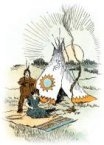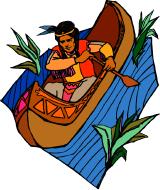
Worksheets and No Prep Teaching Resources
Reading Comprehension Worksheets
Native Americans

Native Americans
 Worksheets and No Prep Teaching Resources Reading Comprehension Worksheets Native Americans |
 Native Americans |
| edHelper's suggested reading level: | grades 4 to 6 | |
| Flesch-Kincaid grade level: | 7.38 |
|
Native Americans of the Northeast Cultural Area
By Jennifer Kenny |

|
 1 The Eastern Woodlands is the eastern part of the United States, from the Atlantic Ocean to the Mississippi River. It includes the Great Lakes. Most scientists divide the region into the Northeast and the Southeast. The Northeast portion of the region runs from Canada to Kentucky and Virginia. It has a temperate climate. It is somewhat humid. There are widespread forests and hundreds of rivers. Much of the soil is adequate for agriculture.
1 The Eastern Woodlands is the eastern part of the United States, from the Atlantic Ocean to the Mississippi River. It includes the Great Lakes. Most scientists divide the region into the Northeast and the Southeast. The Northeast portion of the region runs from Canada to Kentucky and Virginia. It has a temperate climate. It is somewhat humid. There are widespread forests and hundreds of rivers. Much of the soil is adequate for agriculture. |
Create Weekly Reading Books
Prepare for an entire week at once! |
| Leave your feedback on Native Americans of the Northeast Cultural Area (use this link if you found an error in the story) |
 |
Native Americans
|
 |
United States
|
|
|
 | Fifty States Theme Unit |
 |
Document Based Activities |